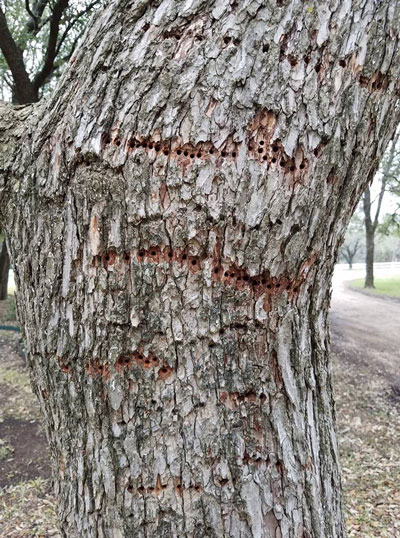Question of the Week – Number 2: January 24, 2019

“I was doing some winter pruning on my trees and saw this damage to elms, oaks and pecans. What can I do to stop it?”
This really isn’t damage in the purest sense. It’s the works of sapsuckers or woodpeckers, two related types of birds.
Simple ways to differentiate holes and their damage…
1. Birds. If the holes are in rows, almost as if someone had strafed the tree’s trunk with machine gun fire, that’s the work of a sapsucker or woodpecker (often just one bird).
These birds do not indicate presence of any insects, nor do they pose any major threat to your trees. Only when they completely riddle the trunk of a tree is there any risk of losing a trunk or the entire tree.
Do not do anything to harm the birds. In fact, that would be illegal. Instead, wrap the trunk with paper tree wrap. In an extreme case you could apply Tree Tanglefoot to the affected area. It’s an ultra-sticky goo that the birds don’t like. They’ll encounter it, and quickly fly on to another trunk in another place.
2. Borers. If the holes are randomly spaced, generally fewer in numbers, that’s almost assuredly the work of borers, and they can be extremely damaging. They’re the larval forms of beetles and moths. The adult females lay their eggs on or in a particular species. The larvae feed on and develop within the wood of the trunk or branch, gaining their nutrients in the process. Eventually they emerge as flying adults and begin the next generation.
There are many types of borers affecting many species of trees. Usually a given borer will attack only one species of tree or a closely related group of trees. Controlling them is difficult and specific to the type of borer involved. Since this question is more about sapsuckers and woodpeckers, I’ll leave additional borer information for you to pull off the Texas A&M horticulture and entomology websites.
